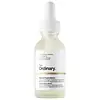What's inside
What's inside
 Key Ingredients
Key Ingredients

No key ingredients
 Benefits
Benefits

 Concerns
Concerns

 Ingredients Side-by-side
Ingredients Side-by-side

Water
Skin ConditioningAlpha-Arbutin
AntioxidantPhenethyl Alcohol
MaskingHydroxyethylcellulose
Emulsion StabilisingPropylene Glycol
HumectantAloe Barbadensis Leaf Juice Powder
Skin ConditioningTriethanolamine
Buffering1,2-Hexanediol
Skin ConditioningCitric Acid
BufferingGlycerin
HumectantSodium Acetate
BufferingCitrus Grandis Peel Water
HumectantSodium PCA
HumectantIsopropyl Alcohol
SolventPentylene Glycol
Skin ConditioningCellulose
AbsorbentErythritol
HumectantCarrageenan
Sodium Acetylated Hyaluronate
HumectantSodium Hyaluronate
HumectantXanthan Gum
EmulsifyingSodium Hyaluronate Crosspolymer
HumectantEthylhexylglycerin
Skin ConditioningHydrolyzed Sodium Hyaluronate
Skin ConditioningPhenoxyethanol
PreservativeWater, Alpha-Arbutin, Phenethyl Alcohol, Hydroxyethylcellulose, Propylene Glycol, Aloe Barbadensis Leaf Juice Powder, Triethanolamine, 1,2-Hexanediol, Citric Acid, Glycerin, Sodium Acetate, Citrus Grandis Peel Water, Sodium PCA, Isopropyl Alcohol, Pentylene Glycol, Cellulose, Erythritol, Carrageenan, Sodium Acetylated Hyaluronate, Sodium Hyaluronate, Xanthan Gum, Sodium Hyaluronate Crosspolymer, Ethylhexylglycerin, Hydrolyzed Sodium Hyaluronate, Phenoxyethanol
Water
Skin ConditioningGlycerin
HumectantAlgae Extract
EmollientPseudoalteromonas Exopolysaccharides
Skin ConditioningPseudoalteromonas Ferment Extract
HumectantAhnfeltia Concinna Extract
Skin ConditioningArginine
MaskingGlycine
BufferingAlanine
MaskingSerine
MaskingValine
MaskingIsoleucine
Skin ConditioningProline
Skin ConditioningThreonine
Histidine
HumectantPhenylalanine
MaskingAspartic Acid
MaskingPCA
HumectantSodium PCA
HumectantSodium Lactate
BufferingSalicylic Acid
MaskingCitric Acid
BufferingPropanediol
SolventDimethyl Isosorbide
SolventEthoxydiglycol
HumectantPolysorbate 20
EmulsifyingPotassium Sorbate
PreservativeSodium Salicylate
PreservativeSodium Benzoate
MaskingHexylene Glycol
Emulsifying1,2-Hexanediol
Skin ConditioningPhenoxyethanol
PreservativeCaprylyl Glycol
EmollientWater, Glycerin, Algae Extract, Pseudoalteromonas Exopolysaccharides, Pseudoalteromonas Ferment Extract, Ahnfeltia Concinna Extract, Arginine, Glycine, Alanine, Serine, Valine, Isoleucine, Proline, Threonine, Histidine, Phenylalanine, Aspartic Acid, PCA, Sodium PCA, Sodium Lactate, Salicylic Acid, Citric Acid, Propanediol, Dimethyl Isosorbide, Ethoxydiglycol, Polysorbate 20, Potassium Sorbate, Sodium Salicylate, Sodium Benzoate, Hexylene Glycol, 1,2-Hexanediol, Phenoxyethanol, Caprylyl Glycol
 Reviews
Reviews

Ingredients Explained
These ingredients are found in both products.
Ingredients higher up in an ingredient list are typically present in a larger amount.
1,2-Hexanediol is a synthetic liquid and another multi-functional powerhouse.
It is a:
- Humectant, drawing moisture into the skin
- Emollient, helping to soften skin
- Solvent, dispersing and stabilizing formulas
- Preservative booster, enhancing the antimicrobial activity of other preservatives
Citric Acid is an alpha hydroxy acid (AHA) naturally found in citrus fruits like oranges, lemons, and limes.
Like other AHAs, citric acid can exfoliate skin by breaking down the bonds that hold dead skin cells together. This helps reveal smoother and brighter skin underneath.
However, this exfoliating effect only happens at high concentrations (20%) which can be hard to find in cosmetic products.
Due to this, citric acid is usually included in small amounts as a pH adjuster. This helps keep products slightly more acidic and compatible with skin's natural pH.
In skincare formulas, citric acid can:
While it can provide some skin benefits, research shows lactic acid and glycolic acid are generally more effective and less irritating exfoliants.
Most citric acid used in skincare today is made by fermenting sugars (usually from molasses). This synthetic version is identical to the natural citrus form but easier to stabilize and use in formulations.
Read more about some other popular AHA's here:
Learn more about Citric AcidGlycerin is already naturally found in your skin. It helps moisturize and protect your skin.
A study from 2016 found glycerin to be more effective as a humectant than AHAs and hyaluronic acid.
As a humectant, it helps the skin stay hydrated by pulling moisture to your skin. The low molecular weight of glycerin allows it to pull moisture into the deeper layers of your skin.
Hydrated skin improves your skin barrier; Your skin barrier helps protect against irritants and bacteria.
Glycerin has also been found to have antimicrobial and antiviral properties. Due to these properties, glycerin is often used in wound and burn treatments.
In cosmetics, glycerin is usually derived from plants such as soybean or palm. However, it can also be sourced from animals, such as tallow or animal fat.
This ingredient is organic, colorless, odorless, and non-toxic.
Glycerin is the name for this ingredient in American English. British English uses Glycerol/Glycerine.
Learn more about GlycerinPhenoxyethanol is a preservative that has germicide, antimicrobial, and aromatic properties. Studies show that phenoxyethanol can prevent microbial growth. By itself, it has a scent that is similar to that of a rose.
It's often used in formulations along with Caprylyl Glycol to preserve the shelf life of products.
Sodium PCA is the sodium salt of pyroglutamic acid. It is naturally occurring in our skin's natural moisturizing factors where it works to maintain hydration.
The PCA stands for pyrrolidone carboxylic acid, a natural amino acid derivative.
This ingredient has skin conditioning, anti-inflammatory, and humectant properties. Humectants help hydrate your skin by drawing moisture from the air. This helps keep your skin moisturized.
Learn more about Sodium PCAWater. It's the most common cosmetic ingredient of all. You'll usually see it at the top of ingredient lists, meaning that it makes up the largest part of the product.
So why is it so popular? Water most often acts as a solvent - this means that it helps dissolve other ingredients into the formulation.
You'll also recognize water as that liquid we all need to stay alive. If you see this, drink a glass of water. Stay hydrated!
Learn more about Water